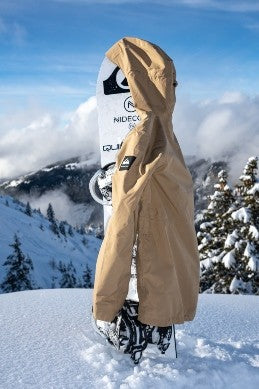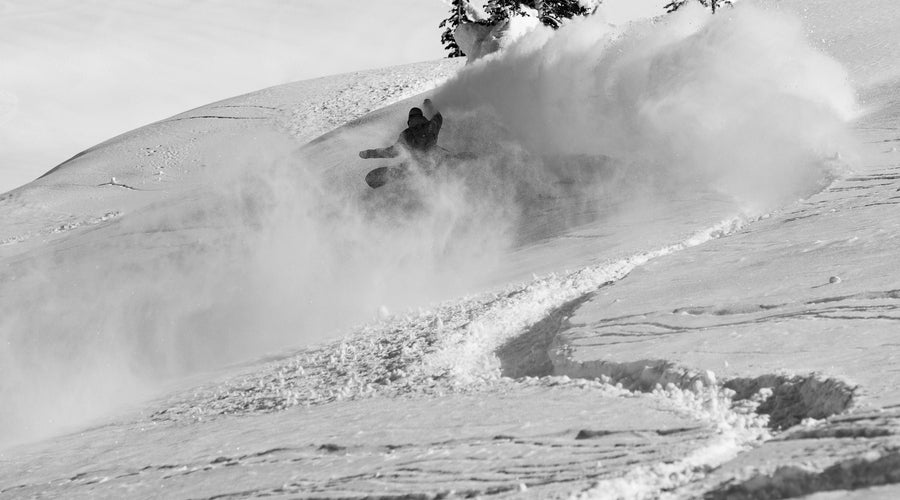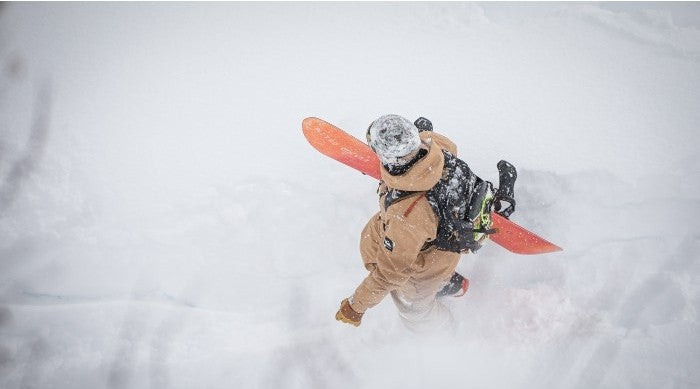Quality snow and ski outerwear is worth the investment and will keep you warm and dry for years – if you take care of it. Washing your technical apparel does not ruin it as clean snow and ski outerwear performs better. In this guide we give you the general rules of washing, drying, and maintaining your technical apparel so you can get the best out of your snow gear season after season.
Important: Before washing anything, always check with the manufacturer for specific care instructions.
Why Is It Important To Wash Your Ski and Snow Clothes?
Aside from keeping your clothes fresh, proper washing and drying helps maintain the performance of your outerwear. Here’s why:
Most manufacturers treat their technical snow outerwear — like shell jackets and ski pants — with DWR. A durable water repellent treatment, abbreviated to DWR, is a finishing that coats the fabric and lowers the surface tension of the fabric, causing water to bead up and run off. You will find this finish on virtually all of your waterproof gear and GORE-TEX products.
A buildup of dirt, oil, and grime can compromise the DWR membrane’s ability to repel water. But washing and low-heat drying reactivates it. Once your snow outerwear becomes dirty or starts absorbing water — known as “wetting out” — it is time to clean it.
How To Wash Snow Outerwear
These are the best practices for washing your snow gear but always check the care label for any special instructions.
1. Prep Your Gear- Check Labels, Pockets and Zips
Make sure you remove everything from the pockets and close the zippers, leg and arm vents, pocket flaps, studs and velcro straps. Separate your technical layers — like your bibs, pants, and jackets — from your base layers and other clothing. Wash your snow outerwear separately from your regular clothes. You can wash your technical apparel together if they have the same instructions but keep it limited to two items per cycle.
2. Pre-Treat Large Stains
Treat large stains before washing your items in a machine. Do not use store-bought stain removers as these can strip water-repellent and waterproofing treatments. Rub the stain with a damp cloth or spot treat the stain by soaking it in an outerwear-specific technical wash before putting your snow gear in the washer. If stains are stubborn, include a gentle prewash cycle.
3. Use a Technical Wash
What detergents can I use?
Avoid household powder and liquid detergents, bleach, or fabric softeners when cleaning your snow gear as the residue they leave behind will block water repellency and breathability. Instead, opt for an additive-free technical outerwear wash like those offered by Nikwax and NST. Always check that what you’re using is compatible with your type of outerwear.
4. Select the Right Cycle
Be sure to check product labels and wash within the guidelines; however, most waterproof snow pants and jackets can be washed in a machine on a cold and gentle cycle: max 80-85°F at a low spin. Hand washing with a technical wash in lukewarm water is also possible if you don't have access to a washer.
SHOP SNOW CLOTHES
How To Dry Snow Outerwear
When it comes to drying snow outerwear, you have two options: tumble dry or air dry.

Tumble Drying
DWR wears out over time but tumble drying your gear once it has been washed reactivates the water-repellent finish. Tumble drying on a low to medium heat for 20 minutes or longer should do the trick but follow the manufacturer’s recommended heat and time settings.
Air Drying
If you air dry, choose a warm and dry area and let your snow gear dry on its own. Do not hang the garment in direct sunlight or over extreme heat sources (i.e. a heater). Prolonged sun exposure can cause the color to fade and heat exposure can damage the waterproof/breathable coating. When the garment is dry, use an iron to reactivate the DWR. Set the iron to the warm/gentle setting and place a thin towel or cloth on your garment before you begin.
After you complete the steps, water should bead up and roll off your technical garment. If you still see areas where the water soaks into the fabric, it is time to reapply a DWR coating.
How to Reproof Your Waterproof Snow & Ski Wear
If you feel your ski/snow clothes have lost some of their water repellency, you can replenish their DWR treatment in one of two ways:
- Wash-In Treatment: this product is designed to restore water repellency and breathability to every part of the outerwear garment. It’s a great choice if you have an older or heavily used shell jacket or ski pants, as these don’t have linings that will be affected.
- Waterproofing Spray: these sprays are a quick and easy way to apply treatment. The spray applies a thin clear coating that won’t affect breathability or the look and feel of the fabric. It also allows you to single out specific areas of the jacket that need waterproofing and to avoid those that don’t.
Both of these options must be applied to freshly washed garments — see instructions above. After applying the DWR, tumble dry your garment for 20 minutes.

How To Wash and Dry GORE-TEX
Washing your GORE-TEX garments is similar to the steps listed above, with a few extra considerations. Remember to carefully read the manufacturer's label for any special instructions.
- Prep: Remove items from the pockets and close the zippers and straps.
- Machine wash using warm water (105°F/40°C) on a low spin cycle.
- Use a small amount of unscented liquid detergent and double-rinse.
- Tumble dry on low, or line dry and iron on a cool, steam-free setting.
- If necessary, follow the instructions above on how and when to reapply DWR.
If you have a Gore-tex SHAKEDRY garment, check the label for special instructions.
How To Clean Down Jackets and Pants?
Down and synthetic insulated apparel is easy to wash if you know what to do. As long as you follow the laundry instructions, you don’t have to worry about clumped up synthetic or down insulation. Washing jackets or pants with down insulation is similar to what you would do with synthetic insulation.

Washing Your Down Garments
- Read the manufacturers’ label instructions. Prep your snow and ski clothes by emptying and zipping all pockets.
- Use a front-loading washing machine because they are gentler. Top-loading washers have a center agitator that garments can get wrapped and stretched around in the wash cycle, causing damage or rips.
- Choose a down wash. The specific formula works to maintain the down loft and the insulating properties of down. Down wash works well for synthetic insulation too. Measure your cleaner with care. Leftover detergent residue can also alter down and synthetic insulation.
- Using the extra rinse cycle to make sure that the cleaner is fully rinsed out. Leftover cleaner causes the down to clump and the synthetic insulation to compress.
Drying Your Down Outerwear
The drying method is the primary difference between down and synthetic insulated outerwear. Read the specific drying instructions for your garment. Synthetic jackets can usually be tumble-dried on a low setting with ease.
Down items take extra care. It’s best to set your dryer to a low and gentle setting. The most important step for drying down is to add wool dryer balls. Sticking a few balls into the dryer helps to fluff up the down and prevent clumping. If you don’t have wool dryer balls, a few clean tennis balls can do the trick. If you find that your down is still clumping, stop the drying cycle as needed to break up the clumped sections with your hands before putting it back in to finish.
How To Wash for Ski Gloves
Just like your outerwear, your gloves will last longer and perform better with regular care but you should avoid washing your gloves too frequently, once or twice a season is plenty. Never wash leather gloves, use a special leather treatment.
Spot Clean and Freshen
- Give your gloves a good shake to remove excess dirt from inside. Use a brush or damp cloth to remove dirt from the surface.
- If your gloves begin to smell, once they’re dry, sprinkle a small amount of baking soda inside them, hold the wrist closed and shake. Let them sit for a few hours/overnight and shake the baking soda out.
Hand Wash
- Soak your gloves in a bowl of lukewarm water with a little mild liquid detergent.
- Rinse and remove excess water with a towel, don’t wring them out.
- Line dry or put them on a boot dryer to finish.
Machine Washing
- Check the tags to see if your ski gloves are washing machine safe.
- Shake gloves to remove dirt and put them in a mesh laundry bag to prevent damage during the wash cycle.
- Use a small amount of unscented, mild liquid detergent.
- Select the gentle/delicate cycle on the machine and use the coldest water.
- Line dry to finish.
How Often Do You Wash Your Ski or Snow Clothes?
During the season, this will depend on a couple of factors: how often you wear your snow gear, how much you sweat, and how dirty it is. Sweat, oil, dirt, etc. will build up over time and inhibit water repellency leading water to soak into the outerwear, rather than beading up and rolling off. Clean outerwear performs better. Follow the laundry and drying instructions above to keep your apparel in top condition.
If you don’t notice any issues as a general rule, wash your ski and snow clothes at the end of each season, before you put them in storage. When winter rolls around again, you’ll be ready to go.


























